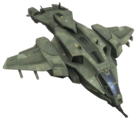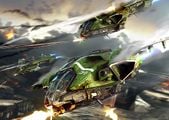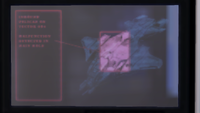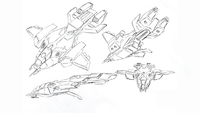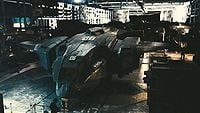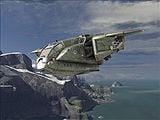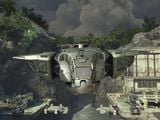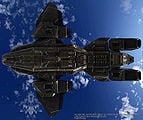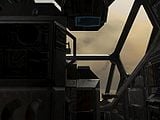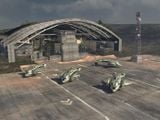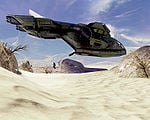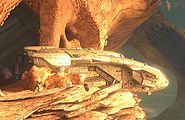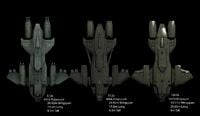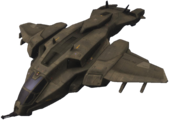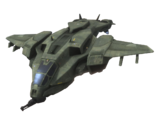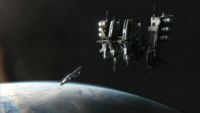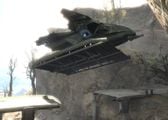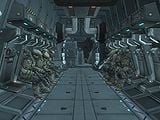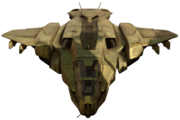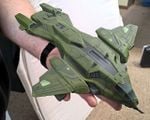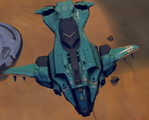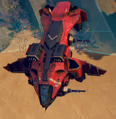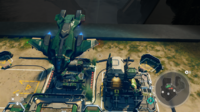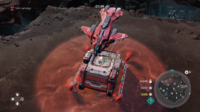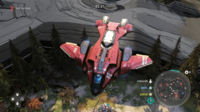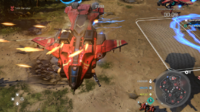D77H Pelican
From Halopedia, the Halo wiki
| Dropship 77 Heavy-Troop Carrier/Infantry | |
|---|---|
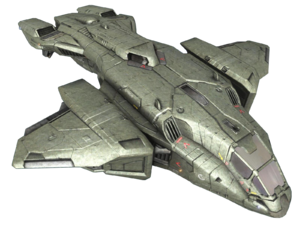
| |
| Production information | |
|
Manufacturer: |
|
|
Role: |
|
| Technical specifications | |
|
Length: |
31.2 meters (102 ft)[2] |
|
Width: |
25.5 meters (84 ft)[2] |
|
Engine(s): |
|
|
Armament: |
|
|
Crew: |
|
| Chronological and affiliation | |
|
Era: |
|
|
Affiliation: |
|
The Dropship 77 Heavy-Troop Carrier/Infantry (D77H-TCI) is a dropship in the ubiquitous Pelican line of armed transports built by Misriah Armory.[1][5] It was introduced as a variant of the older D77 Pelican,[2] and has been dominant in United Nations Space Command armouries for decades.[1]
Overview[edit]
Design details[edit]
Like its standard D77 forebear, the D77H is an extremely versatile airframe. It features a power-efficient thruster configuration and dense ablative armour plating that make it suited for quick-transfer deployments deep into enemy territory. Where it differs most from the traditional D77 design is in the cockpit; where the D77 features tandem seating,[3] the D77H features vertically staggered seats for its crew, with a co-pilot situated behind the pilot.[1] The cockpit features a holopedestal that allows for the display of a smart AI.[6] Other differences include the arrangement of the wings. The "shoulders" connecting the fuselage to the wing are much larger and more armoured on the D77H, with the wing itself only having one control surface on the back of the wing, rather than the two per-wing present on the regular D77.[4] The dorsal surface of the craft contains a gravitic-assist, which helps provide lift and stability during atmospheric flight.[3] The craft has four hybrid fusion drives, with an engine pod situated in both of the wings, and with two located at the aft of the vehicle. Each drive consists of a vectored-thrust fusion ram-rocket with an air-breathing hyperfan. When operating in space, the ram-rockets require hydrogen reaction mass. The Pelican carries enough on-board fuel for two ground-orbit trips.[3]
As-standard, the craft can carry up to 18 personnel; 3 crew (a pilot, a co-pilot, and a crew chief) and 15 passengers. However, this capacity can be upgraded for higher troop concentrations.[2] The rear bay, or "blood tray",[7] seats these infantry in jumpseats lining the sides, with a space in the middle which can be used for installing benches, cargo pallets, casualty stretchers, or even smaller utility vehicles like a Mongoose quad bike.[3] Alternatively, the seating can be ripped out to make for more space in the bay if required for more specialised deployments.[8]
A larger vehicle, such as a Warthog or Scorpion tank, can be lifted in the magnetic cargo clamp situated behind the troop bay. This clamp can also be used to carry a cargo pod or up to six resupply capsules;[2] however, using it in this manner during orbital reentry is discouraged due to the complications it adds.[3]
Armament[edit]
The D77H's standard weapons loadout includes two integrated Anvil-II air-to-surface missile pods integrated seamlessly into the wing, below the fusion drive assembly.[1] Each pod contains six silos.[4] In addition, a Class-1 weapon hardpoint is fitted in the rear bay.[5] This can be used to fit a heavy machine gun, grenade launcher, or even a Gauss cannon to provide protection for the bay during infantry embarking or disembarking.[3] The most commonly-seen armament in the D77H bay is a tripod-mounted AIE-486H machine gun.[4]
Despite the standard armaments, the D77H is as versatile in its loadout as its D77 forebear.[1] As such, more heavily-armed variants exist.[5] A chin-mounted Class-3 weapons hardpoint is present on the craft's nose[5] that can be used to equip an autocannon such as the M340 40mm or M370 70mm.
Variants[edit]
- UNICOM Pelican - an altered D77H used by the UNSC Army and UNSC Air Force during the Fall of Reach, boasting only ten seats in the passenger bay and other minor alterations to the body.
- D77C Pelican - a civilian variant of the D77H-TCI, replacing military armaments with sensors. These are mostly used by government, corporate, and law enforcement agencies such as the New Mombasa Police Department.
- G77S Pelican - a gunship conversion of the D77H, boasting a much heavier ordnance loadout for ground support.
A Pelican used by UNICOM forces during the Fall of Reach. This variant only contains ten seats for passengers.
Identified Pelicans[edit]
Operational history[edit]
D77H Pelicans saw heavy use during the Battle for Earth in November 2552, alongside the ensuing campaign on Installation 00.[4]
Production notes[edit]
The 2009 Halo Encyclopedia lists the D77H-TCI's length and width stats as 30 meters (100 ft) and 23 meters (77 ft), respectively.[9] This was updated in the book's 2011 reissue to 31.2 meters (102.3 ft) and 25.5 meters (83.7 ft).[2]
Early concept art for the D77H produced by Isaac Hannaford during Halo 3's production depicted the craft with much more exaggerated weapons and sensor antennae on its nose.[10] This concept was reused as a texture on the laptop display screen inside the base on the multiplayer map High Ground, and was also later revisited during the concept phase for the Halo Legends episode Homecoming.
Halo: Reach model[edit]
The Pelican model found in Halo: Reach is called out in the game's manual and in-game tooltips as a regular D77 Pelican, despite otherwise being almost identical to the D77H design introduced in Halo 3 (particularly the broader shoulders, the control surfaces on the wings and the vertically-stacked cockpit alignment - the latter of which was specifically noted in the 2022 Halo Encyclopedia as a signature element of the D77H[1]). As such, this page considers the Reach manual and other sources which label it as a D77-TC to be an error.
The Reach model was reused in Halo: Combat Evolved Anniversary and Halo 2: Anniversary's campaign gameplay including the updated cockpit alignment - though for Halo 2: Anniversary Blur Studio also made their own VFX-quality Pelican in the original D77 style for use in the game's prerendered cutscenes. The Reach/Anniversary Pelican was also later used as the basis for the design featured in Halo Wars 2.
Gallery[edit]

|
Browse more images in this article's gallery page. |
Halo 3 design[edit]
D77H-TCI dropship outside The Pit.
A D77H-TCI dropping off two ODSTs on Installation 00.
A D77H-TCI crashed on High Charity.
Halo: Reach design[edit]
A Pelican approaches the UNSC Hopeful in the Birth of a Spartan short live-action film.
A Pelican during the Battle at Szurdok Ridge.
A Pelican carrying a deployable bridge.
The crashed Bravo 001 in the Military Wilderness Training Preserve.
An angled profile view of a Pelican in Halo: Combat Evolved Anniversary.
Two Pelicans during the Battle of the Silent Cartographer in Combat Evolved Anniversary.
Several D77Hs along with Longswords during the mission to Ven III.
A D77H Pelican in Halo: Ground Command.
A D77H Pelican in the Halo Wars 2 Open Beta.
A D77H Pelican delivering a UNSC Supply Pad during the Battle of Installation 00 in Halo Wars 2.
A D77 delivering a Watchtower.
A D77H in comparison to a G81 Condor.
List of appearances[edit]
- Halo: Landfall (First appearance)
- Halo 3
- Halo: Reach[Note 1]
- Halo: Spartan Assault
- Halo: Escalation
- Halo Mythos
- Halo: Rise of Atriox
- Halo: Shadows of Reach
Notes[edit]
- ^ Though the Halo: Reach manual identifies the Pelican in the game as the D77-TC model, all Pelicans seen in-game have the same internal design as the D77H-TCI, notably including the tandem seating configuration. This is most easily seen in the level The Pillar of Autumn.
Sources[edit]
- ^ a b c d e f g h Halo Encyclopedia (2022 edition), page 149
- ^ a b c d e f g Halo Encyclopedia (2011 edition), page 262
- ^ a b c d e f g Halo: Warfleet, page 44-45: While the page in question specifically discusses the standard D77, the general details are applicable to all D77 Pelican models.
- ^ a b c d e Halo 3, Pelican in-game model
- ^ a b c d e f halo3.com, Weapons & Vehicles: Pelican (Retrieved on Dec 30, 2007) [local archive] [external archive]
- ^ a b Halo 3, campaign level Halo
- ^ Halo: Ghosts of Onyx, chapter 23
- ^ Halo: Shadows of Reach, chapter 17
- ^ Halo Encyclopedia (2009 edition), page 252
- ^ The Art of Halo 3, page 38-39
| |||||||||||||||||
| ||||||||||||||||||||||||||||||||||||||||||||||||||||||||
